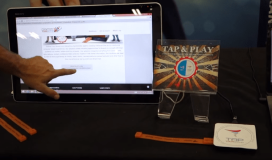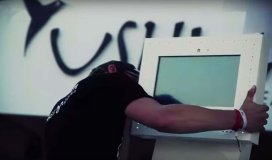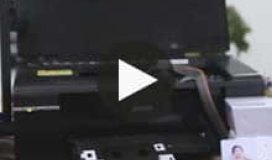Last November, the Children's Museum of Houston launched its Special Elite Crime Resolution and Espionage Team (SECRET) scavenger hunt. The process requires young patrons, ages six to 12, to complete a series of missions that can require multiple visits to the museum, as well as many hours of hard play and work on the part of children and their parents. The game is enabled by passive low-frequency (LF) RFID technology to link each player to his or her missions via an RFID-tagged wristband known as a Codex.
Since taking the system live, the Children's Museum of Houston has seen its membership increase, according to Keith T. Ostfeld, the museum's director of educational technology and exhibit development. That, he says, is because players, after completing one or two missions, are likely to want to return for more challenges, which makes a membership more economical for families than buying tickets for each visit.
A player's goal during each mission is to protect an underground vein of crystals that emit strange energies that could revolutionize how the world gets its power. In so doing, they must also thwart the Ridiculously Intelligent Villainous Agent's League (RIVAL), an evil organization that is attempting to steal the crystals.
The game itself is designed to exercise the mind and the body, Ostfeld explains. "The purpose of this experience is to encourage kids to utilize key skills," he says, including problem solving, observation and logical decision making. Each child (with the help of a parent) signs up for a series of six missions that involve a variety of tasks, such as walking through the museum, searching for clues, negotiating mazes, solving riddles, performing calculations and answering questions at kiosks. There is no telling what players may encounter on any given mission, Ostfeld says. (The missions' details are kept secret by design, Ostfeld says, so that new participants will not know what to expect.) Typically, they solve one or two missions during their first visit, then return to accomplish others on subsequent trips. It's a workout, both mentally and physically, he notes, since the game is designed so that patrons move about the entire facility.
First, a participant pays a fee—$20 for the first mission and $10 for each subsequent one. Every player receives a Codex wristband containing an EM Microelectronic EM4200 125 kHz LF RFID chip. Each child is also given some gadgets, such as a magnifying glass and a flashlight. Participants can keep the wristband and tools when they leave the museum.
The Children's Museum of Houston worked with Schell Games to develop the scavenger hunt, including software that stores the wristband's unique ID number and links that information to each mission as in which a child participates. Although the software does not collect players' names, it does collect answers to three specific questions—such as "What is your phone number?"—so that a child who loses a wristband can still access his play history and link it to a replacement bracelet.
Once provided with a wristband and gadgets, a player can begin the games—starting with the headquarters, which one enters via a locked door. When a child places her hand on the RFID reader located near the door, the device captures her wristband's ID number, causing the lock to open. Once inside the headquarters, the player proceeds to the mission-briefing kiosk, where another reader captures the bracelets tag ID and provides the child with her assignment. All readers are made with a Phidgets PhidgetRFID (model 1024) printed circuit board.
A task may involve solving a puzzle or negotiating a laser maze ahead of the RIVAL group. After completing the first few assignments, a child graduates to Tier 2 missions, which are more difficult and may require some math or other logic or reasoning skills. Parents are encouraged to participate as well.
Every time a child completes a mission correctly, he enters the data required for that task into an RFID-enabled kiosk. That information is then stored, along with his wristband ID, so that he can be directed to the next assignment when he is ready.
"A mission can take 45 minutes" to complete, Ostfeld states, though some children can take significantly longer, especially if they stop to play with other exhibits or get something to eat. "Saving the world is great—but sometimes, by golly, they need to stop for some fries," he says of the younger participants.
Since the technology was installed, Ostfeld reports, approximately 20 to 30 percent of visitors in the six-to-12 age range have participated in the SECRET game. To date, the museum has sold more than 3,500 missions altogether.
The RFID technology has been working well, Ostfeld says. "It's a very robust system," he explains. "The RFID has been working perfectly."
The next step, Ostfeld notes, will be to add more challenges, including a Tier 3 set of missions that are more difficult than those already being offered. That could require additional RFID-enabled kiosks, as well as changes to the software as more instructions and clues are added. The museum also plans to offer the SECRET system to other museums and organizations, on a franchise basis, starting this fall.
This article is come from rfidjournal.com


